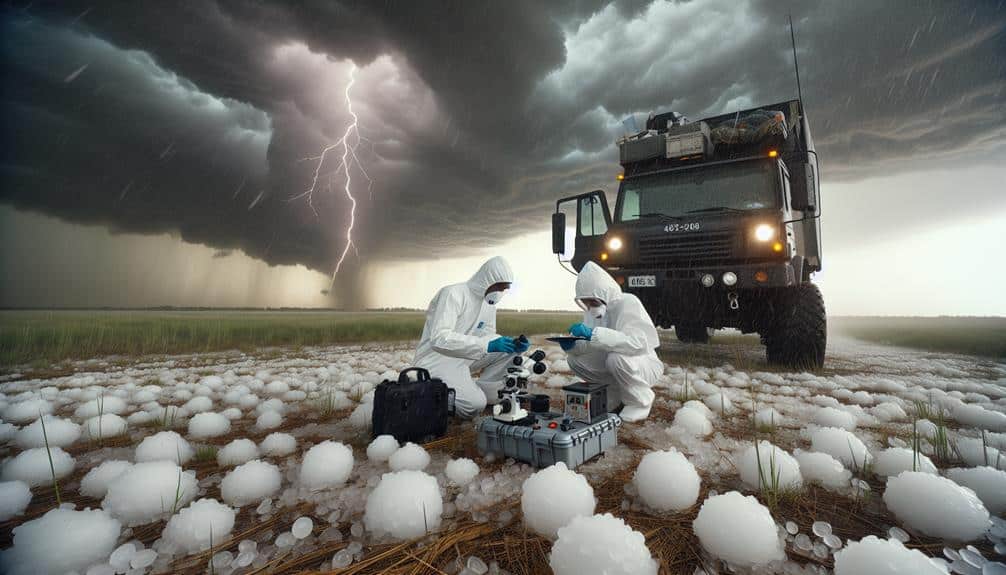Ethical considerations in hailstorm chasing studies are crucial for safeguarding our team's safety and protecting the environment. We conduct thorough risk assessments and implement detailed safety protocols. We also choose low-impact methods to minimize our environmental footprint and safeguard data integrity by meticulously documenting and transparently reporting findings. Engaging stakeholders and respecting community values fosters collaboration and improves public perception. Finally, strict adherence to legal regulations and obtaining the necessary permits guarantees compliance. By upholding these ethical standards, we ensure responsible and efficient research, contributing valuable insights. Discover how these practices shape our approach.
Key Points
- Protect participants by conducting thorough risk assessments and implementing detailed safety protocols.
- Minimize environmental impact through sustainable practices and low-impact methods.
- Ensure data integrity by adhering to ethical guidelines and securing data handling practices.
- Foster community trust and collaboration through transparent communication and stakeholder engagement.
Safety of Participants
Safeguarding the safety of participants in hailstorm chasing studies necessitates thorough risk assessments and the implementation of detailed safety protocols. To uphold participant well-being, we need to conduct in-depth risk management procedures. This involves mapping potential hazards, such as severe weather conditions, and outlining emergency response strategies. By identifying these risks, we can develop all-inclusive training programs for all team members, guaranteeing everyone knows how to react in critical situations.
We prioritize real-time monitoring systems to track hailstorm developments and participant locations. This technology enables us to make informed decisions quickly, reducing the risk of accidents. Additionally, personal protective equipment (PPE) tailored for extreme weather conditions is mandatory for all participants. Helmets, fortified vehicles, and communication devices are essential to minimize potential injuries.
Our data-driven approach includes continuously updating safety protocols based on new research and past experiences. We conduct regular drills to keep everyone prepared and ensure that emergency plans are practical and effective. By putting participant well-being at the forefront of our operations, we enable freedom in research while maintaining high safety standards. This balanced approach allows us to pursue scientific inquiries without compromising the health and safety of our team.
Environmental Impact
Evaluating the environmental impact of hailstorm chasing studies requires a detailed analysis of our interventions and their potential effects on local ecosystems. As researchers, we need to make sure that our activities align with wildlife preservation and pollution prevention goals. When we deploy equipment or traverse sensitive areas, we risk disrupting local habitats. It's important to minimize our footprint by choosing low-impact methods and routes.
Data supports the need for ecosystem protection, especially in light of climate change. Our presence in storm-prone areas can worsen soil erosion and disturb flora and fauna. By using the latest technology, we can gather accurate data while reducing our environmental impact. For example, remote sensing tools can greatly reduce the need for on-ground interventions.
Additionally, we need to take into account the cumulative effects of our fieldwork on pollution levels. The vehicles and equipment we use can contribute to air and soil pollution. Implementing sustainable practices, like using electric vehicles and biodegradable materials, can significantly lessen these impacts.
Data Integrity
Maintaining data integrity in our hailstorm chasing studies is essential to guaranteeing the reliability and validity of our environmental impact assessments. We must adhere to stringent ethical guidelines to make sure that our research findings are accurate and credible. This not only safeguards the scientific community's trust but also upholds the freedom of information that our audience values.
Accurate data collection and analysis are pivotal. Any deviation, whether intentional or accidental, can greatly distort our findings, leading to misguided conclusions and flawed policy recommendations. By rigorously following established ethical guidelines, we minimize the risk of such errors. This involves meticulous documentation of our methodologies, transparent reporting of our data, and thorough peer review processes.
Moreover, we must verify that our data handling practices are secure. Protecting the integrity of our datasets from tampering or unauthorized access is vital. This involves implementing robust cybersecurity measures and maintaining detailed logs of data access and modifications.
Community Relations
Building strong community relations is important for the success and ethical execution of our hailstorm chasing studies. By engaging stakeholders and being mindful of public perception, we can foster a collaborative environment that benefits both researchers and local residents.
Data from recent studies suggest that communities with high levels of engagement report greater trust and willingness to participate in scientific endeavors. As such, we must prioritize stakeholder engagement to make sure our presence is welcomed and our work is understood.
Cultural sensitivity is another significant aspect. Communities often have diverse cultural backgrounds, and respecting these differences is crucial for building community trust. For instance, understanding local customs and traditions can improve our interactions and reduce any potential friction. Data-driven approaches indicate that culturally sensitive practices lead to more effective and harmonious collaborations.
Additionally, transparent communication is key. We should consistently inform the community about our objectives, methodologies, and findings. This transparency not only enhances public perception but also reinforces the ethical framework within which we operate.
Legal Compliance

While fostering community relations is essential, we must also make certain our hailstorm chasing activities adhere strictly to legal regulations and standards. Legal compliance isn't just about avoiding penalties; it's an integral part of our ethical responsibilities. When we respect laws designed to protect the public and the environment, we uphold the integrity of our research ethics.
For instance, obtaining appropriate permits before accessing restricted areas is non-negotiable. This guarantees that we don't inadvertently disrupt sensitive ecosystems or violate property rights. Our vehicles and equipment must also meet safety standards to minimize potential hazards, both for us and for the communities we engage with.
Data collection and sharing practices must comply with privacy laws and ethical guidelines. Unauthorized use of personal data, such as images or location information, can undermine public trust and violate individual rights. We've to be transparent about our methodologies and make certain that our findings are accessible without compromising personal or proprietary information.
Frequently Asked Questions
How Do You Select Safe Locations for Setting up Observation Equipment During Hailstorms?
Like a vigilant scout, we prioritize weather monitoring and site selection. We conduct thorough risk assessments and follow stringent safety protocols to guarantee our equipment is set up in the safest possible locations during hailstorms.
What Specific Technologies Are Used to Predict Hailstorm Occurrences Accurately?
We use weather radar and remote sensing technologies to predict hailstorm occurrences accurately. These tools analyze atmospheric data, measure storm dynamics, and track precipitation patterns, giving us precise forecasts that empower us to act with confidence and freedom.
How Do Researchers Ensure Their Findings Are Accessible to the Broader Scientific Community?
We guarantee our findings are accessible by prioritizing data transparency and fostering research collaboration. We also engage the public and conduct community outreach to disseminate information effectively, empowering the broader scientific community with our objective, data-driven analyses.
What Training Do Hailstorm Chasers Undergo to Handle Emergency Situations?
Like Odysseus sailing through treacherous seas, we undergo emergency response training and master crisis management techniques. This guarantees we're equipped to handle the unpredictable nature of hailstorms, safeguarding our freedom to pursue scientific discovery responsibly.
How Do You Balance the Need for Data Collection With Minimizing Disruption to Local Wildlife?
We balance data collection and minimizing disruption to local wildlife by implementing strict research ethics. We prioritize wildlife preservation and continually assess environmental impact, ensuring our methods are both scientifically rigorous and environmentally responsible.


